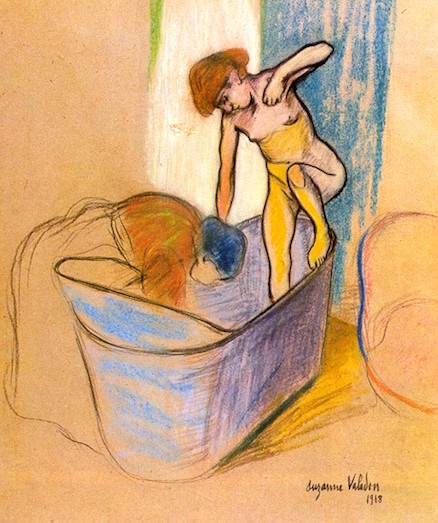
|
|
|
|
|
| Issue 11: | January 2022 |
| Tanka Prose: | 169 words [R] |
By Charles D. Tarlton
Suzanne Valadon’s The Bath[1]

Soon, with a noise like tambourines,
Came her attendant Byzantines.
—Wallace Stevens[2]
Stevens lectures us on lust in his poem “Peter Quince at the Clavier,” specifically in those passages reflecting on the Book of Daniel concerning Susanna’s nakedness in her bath and the lust of the Elders of Babylon. In the natural sphere nakedness is ordinary, any lust that arises (if we can even call it that) being merely animal and instinctual. But bathing, like painting, is not a natural thing and requires a deliberate nudity, something always just a little more naked.[3]
a naked woman painted by a woman, stripped of all fantastical allure stepping in or out of her bath a servant tending to the drain it’s fair to say she’s skinny, not like a nude by Tintoretto his Bathsheba or Susanna here’s interest without lust no one wants to be seen stripping down in the bath clothing roughly tossed away in a flicker, posing there for all to see
Publisher’s Notes:
1. The Bath (Le Bain) (pastel on paper, 1908) by Suzanne Valadon
(1865–1938) is housed at the Musée des Beaux-Arts in Grenoble. Image above
was reproduced from the public domain via Wikimedia:
https://commons.wikimedia.org/wiki/File:ValadonSuzanne_TheBath.jpg
2. Epigraph is from “Peter Quince at the Clavier” by Wallace Stevens
(1879–1955), in his first book of poetry, Harmonium (Knopf, 1923).
3. John Berger, in Ways of Seeing (British Broadcasting Corporation and
Penguin Books, 1972): “To be naked is to be oneself. To be nude is to be seen
naked by others and yet not recognized for oneself. A naked body has to be seen
as an object in order to become a nude...” (page 54).
—Published previously in Tarlton’s book Touching Fire: New and Selected Ekphrastic Prosimetra (KYSO Flash Press, December 2018); appears here with his permission.
For more about Valadon and her work, see Model, Rebel, and Painter, Suzanne Valadon Defied the Odds, a review by Ilene Dube (24 October 2021) in Hyperallergic (independent arts journalism).
Charles D. Tarlton
is a retired university professor of political theory who lives in Old Saybrook, Connecticut with his wife, Ann Knickerbocker (an abstract painter), and a Standard Poodle named Nikki. He is the author of three books of prosimetra published by KYSO Flash Press: Touching Fire: New and Selected Ekphrastic Prosimetra (2018), Get Up and Dance (2019), and Carmody & Blight: The Dialogues (2019).
His most recent book, Peaches and Roses: Episodes in the Navajo Degradation, was released in January 2021 by Silver Bow Publishing (New Westminster, British Columbia). He also has a poetry e-chapbook published in the 2River series, La Vida de Piedra y de Palabra: Improvisations on Pablo Neruda’s Macchu Picchu; an experimental prosimetrum in Lacuna entitled Five Episodes in the Navajo Degradation; “The Rock in a Jar,” an extended prose poem in several parts in Gone Law 32; and “The Turn of Art,” a short prosimetrical drama pitting Picasso against Matisse, in Fiction International.
Tarlton has been writing poetry and flash fiction since 2006, and his work is published in numerous literary journals and magazines: Abramelin, Atlas Poetica, Barnwood, Blackbox Manifold (UK), Blue and Yellow Dog, Book Ends Review, Clackamas Literary Review, Contemporary Haibun Online, Cricket Online Review, Dark Matter, Fiction International, Haibun Today, Ilanot Review, Inner Art Journal, Innisfree Poetry Journal, Jack Magazine, KYSO Flash, Linden Avenue Literary Journal, London Grip, MacQueen’s Quinterly, Muse India, Palette Poetry, Peacock Journal, Prune Juice, Randomly Accessed Poetics, Rattle, Red Booth Review, Red Lights, Review Americana, Ribbons, Shampoo, Shot Glass, Simply Haiku, Six Minute Magazine, Sketchbook, Skylark, Spirit Wind Gallery, Tallow Eider Quarterly, The American Aesthetic, The Ekphrastic Review, The Houston Literary Review, tinywords, Tipton, Unbroken Journal, Undertow Tanka Review, and Ink, Sweat, and Tears.
More on the Web: By, About, and Beyond
⚡ Artifact With Steam (2019) by Ann Knickerbocker, ekphrastic tanka prose in the e-collection Get Up and Dance featured in KYSO Flash (Issue 12, Summer 2019)
⚡ Featured Author Charles D. Tarlton, with six of his ekphrastic tanka prose and an interview with Jack Cooper, in KYSO Flash (Issue 6, Fall 2016)
⚡ Notes for a Theory of Tanka Prose: Ekphrasis and Abstract Art, a scholarly paper by Tarlton residing in PDF at Ray’s Web; originally published in Atlas Poetica (Number 23, pages 87-95)
⚡ Three American Civil War Photographs: Ekphrasis by Tarlton in Review Americana (Spring 2016)
⚡ Simple Tanka Prose for the Seasons, a quartet by Tarlton in Rattle (Issue 47: Tribute to Japanese Forms, Spring 2015)
| Copyright © 2019-2025 by MacQueen’s Quinterly and by those whose works appear here. | |
| Logo and website designed and built by Clare MacQueen; copyrighted © 2019-2025. | |
|
Data collection, storage, assimilation, or interpretation of this publication, in whole or in part, for the purpose of AI training are expressly forbidden, no exceptions. |
At MacQ, we take your privacy seriously. We do not collect, sell, rent, or exchange your name and email address, or any other information about you, to third parties for marketing purposes. When you contact us, we will use your name and email address only in order to respond to your questions, comments, etc.